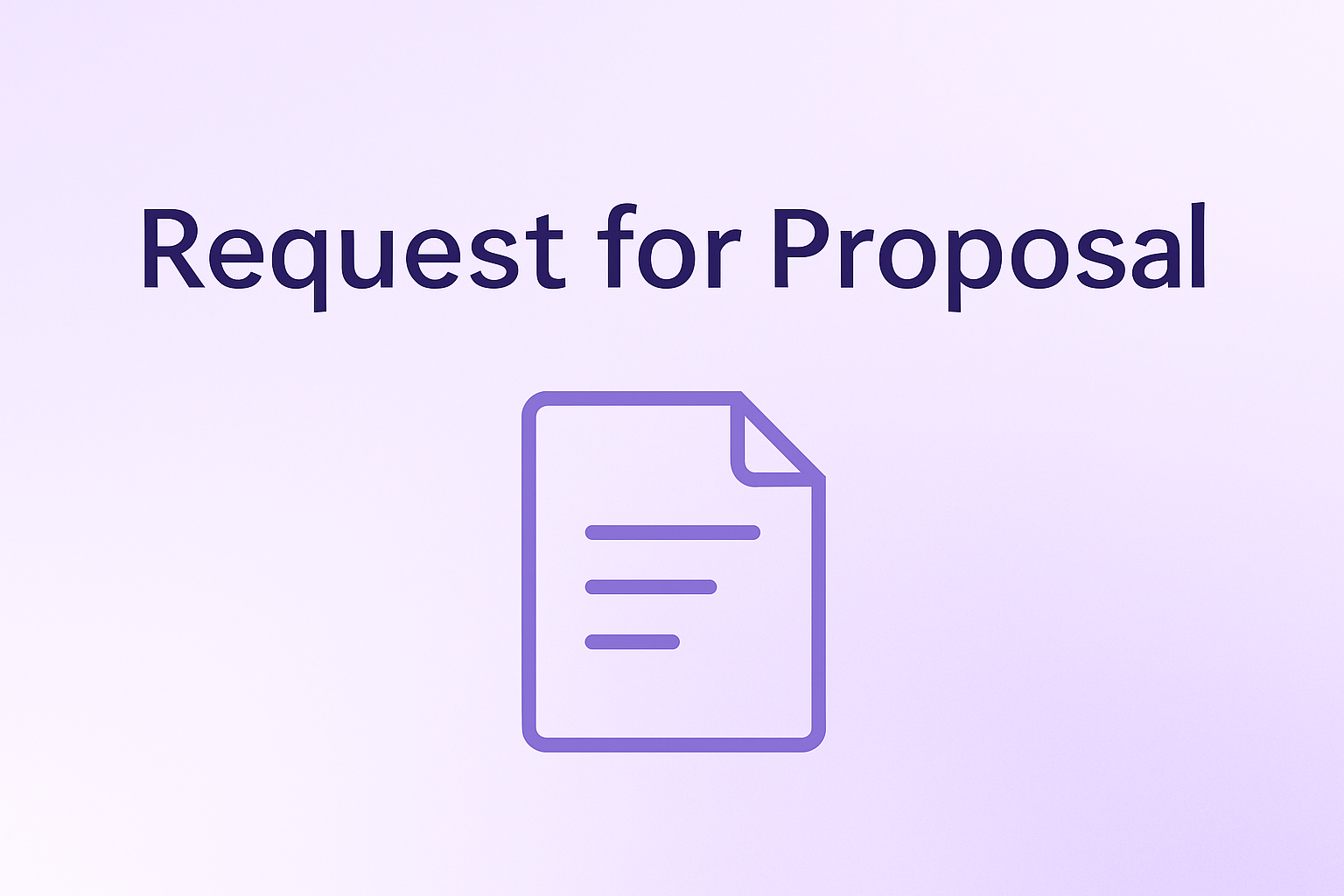What Is an RFP (Request for Proposal)? Uses & Key Elements

What is an RFP?
A Request for Proposal (RFP) is a formal document organizations use to solicit bids from potential vendors when they have a defined business problem but are open to multiple solutions.
Unlike an RFQ (Request for Quotation), which focuses primarily on price, or an RFI (Request for Information), which gathers early-stage insights, an RFP is designed to evaluate how vendors approach solving a specific challenge—and which partner offers the most value, innovation, and alignment with the buyer’s goals.
Purpose of an RFP
RFPs bring structure and transparency to the vendor selection process. They help organizations:
- Compare vendors objectively by using standardized proposal formats.
- Encourage creativity and innovation, giving vendors room to propose unique solutions.
- Drive collaboration across internal teams such as finance, operations, and IT.
- Ensure fairness and accountability by evaluating proposals against defined criteria.
The RFP process helps companies move beyond price competition toward strategic partnerships built on value and capability.
When to Use a Request for Proposal
An RFP is most effective when:
- The problem is clearly defined, but the solution is not.
- Multiple vendors could address the challenge in different ways.
- The project involves collaboration, customization, or technical implementation.
- The organization seeks a long-term partner, not a one-time transaction.
For example, a company looking to improve customer onboarding might issue an RFP to explore solutions such as CRM software, automation tools, or user experience consulting—all with different approaches to achieving the same goal.
Related reading: What Is an RFQ? Meaning, Use & Sample Template
Key Components of an RFP
A strong RFP gives vendors the clarity to respond effectively while enabling buyers to evaluate proposals consistently.
- Introduction: Provide background about your organization, goals, and challenges.
- Problem Statement: Describe what you’re trying to solve and why it matters.
- Scope of Work: Outline project requirements, deliverables, and timelines.
- Submission Guidelines: Specify formatting, deadlines, and points of contact.
- Evaluation Criteria: Be transparent about what matters most—cost, technical fit, innovation, or implementation speed.
Learn more: RFP Evaluation
Benefits of Using RFPs
- Objectivity: Enables side-by-side comparison of proposals.
- Transparency: Promotes fairness and reduces bias in vendor selection.
- Innovation: Encourages vendors to propose creative solutions.
- Collaboration: Aligns internal stakeholders around shared success metrics.
- Accountability: Documents decision-making for compliance and future reference.
Best Practices for RFP Management
- Be specific but flexible: Define goals clearly but allow room for innovation.
- Offer a Q&A period: Give vendors an opportunity to clarify details before submission.
- Use automation tools: Platforms like Iris Pro streamline response management, scoring, and collaboration.
- Follow up professionally: Notify all vendors of the outcome to maintain positive relationships for future projects.
Related: RFP Automation for SaaS Companies
When Not to Use an RFP
You may not need an RFP if:
- You already have a preferred vendor or renewal contract.
- The project is price-driven (use an RFQ instead).
- The project scope is still undefined (start with an RFI).
Why RFPs Matter
RFPs are more than procurement paperwork—they’re frameworks for strategic partnerships. When done correctly, they promote clarity, accountability, and creativity across every stakeholder involved.
A successful RFP doesn’t just find the lowest price—it finds the right fit.
Continue reading: RFP Cover Letter | Sample RFP Response
RFP (Request for Proposal) – FAQ
What is the main purpose of an RFP?
A Request for Proposal’s main purpose is to invite detailed proposals from potential vendors to solve a specific business need. It allows organizations to evaluate various solutions and vendor capabilities beyond just cost, helping them find the best overall fit or partner for a project.
How is an RFP different from an RFQ or RFI?
An RFP asks vendors to propose how they would solve a problem, focusing on solution quality and vendor expertise. In contrast, an RFQ (Request for Quotation) is only used to get price quotes for a clearly defined product or service, and an RFI (Request for Information) is a preliminary request to gather general information about potential solutions or vendors before any formal proposals are solicited.
When should I use an RFP instead of an RFQ?
Use an RFP when your project requires creativity or a tailored solution and you want to evaluate vendors on factors like approach, experience, and value – not just price. If your requirements aren’t completely fixed or you’re seeking a long-term partner to solve a problem, an RFP is more appropriate than an RFQ (which is reserved for straightforward purchases decided mostly on price).
What should be included in an RFP?
A well-written RFP includes background information on the project, a clear description of the requirements or scope of work, instructions for how vendors should structure and submit their proposals, and the criteria that will be used to evaluate those proposals. These components ensure vendors understand exactly what the buyer needs and how their responses will be judged.
Can RFPs be automated or streamlined with software?
Yes. Many organizations use RFP management software to streamline the RFP process. For example, specialized tools (like Iris) can automate tasks such as organizing content, auto-filling answers from a knowledge library, coordinating team input, and even scoring proposals – making the RFP response workflow faster and more efficient.
How are RFP responses evaluated?
RFP responses are usually evaluated against the criteria set out in the RFP document. A review team will score each proposal on factors such as how well the solution meets the requirements, the total cost of the proposal, the vendor’s experience or qualifications, and other defined criteria, then compare the scores to select the vendor that offers the best overall value.
Related Glossary Terms
Explore Examples of Use Cases
- RFP Automation for Healthcare Companies
- RFP Automation for Financial Services
- RFP Automation for Government & Public Sector Teams
- RFP Automation for EdTech & Education Organizations
- RFP Automation for Real Estate & Construction Companies
- RFP Automation for Cybersecurity & IT Security Providers
- RFP Automation for SaaS Companies
- RFP Automation for Manufacturing & Industrial Companies
















